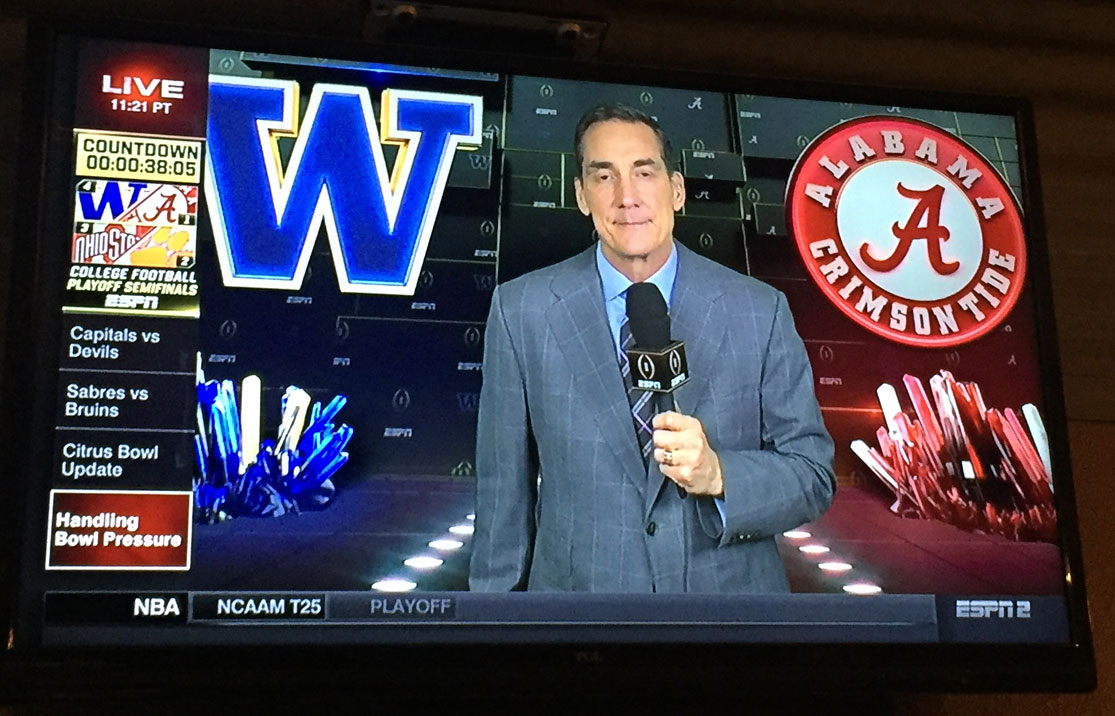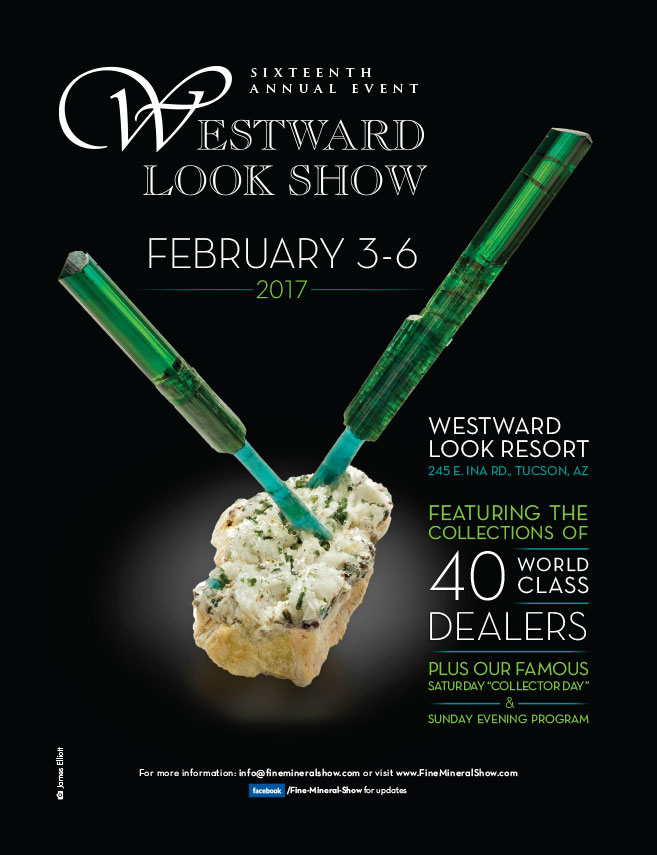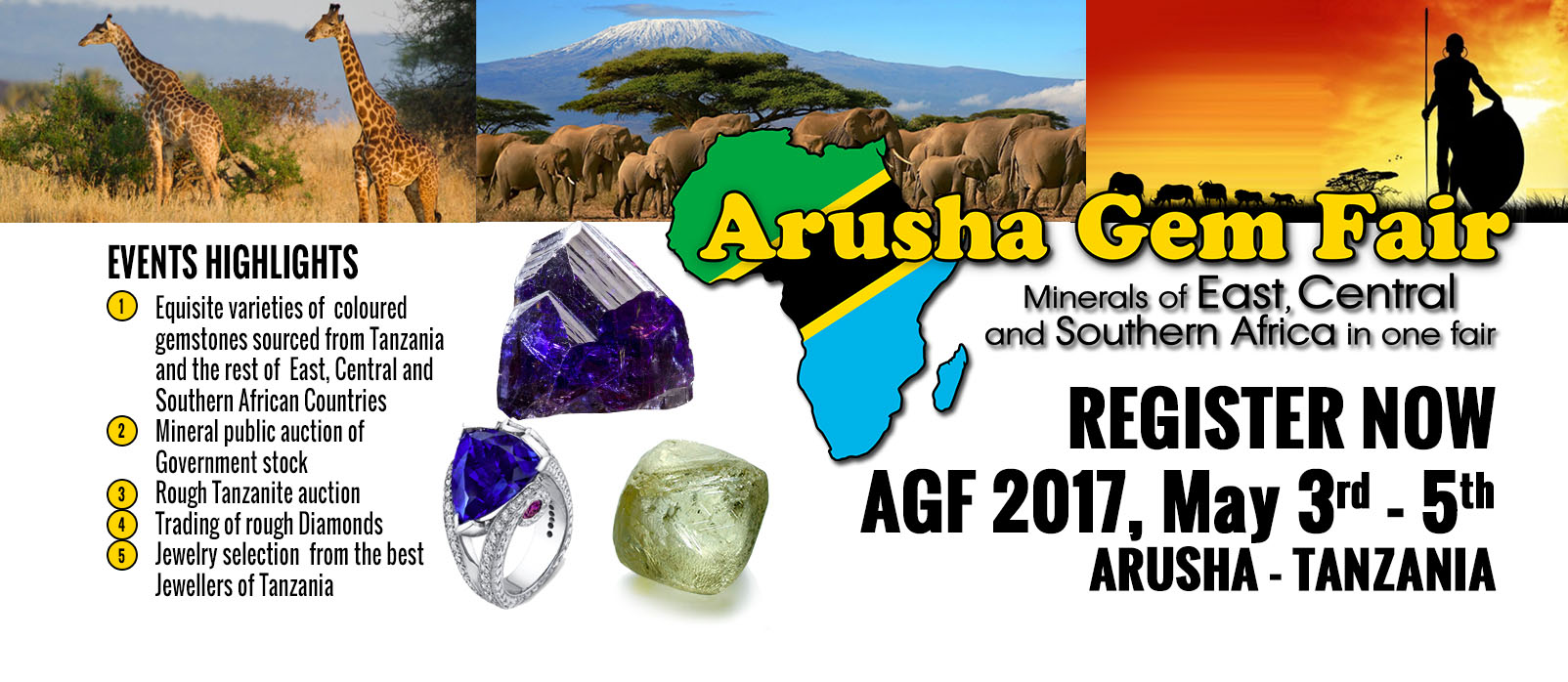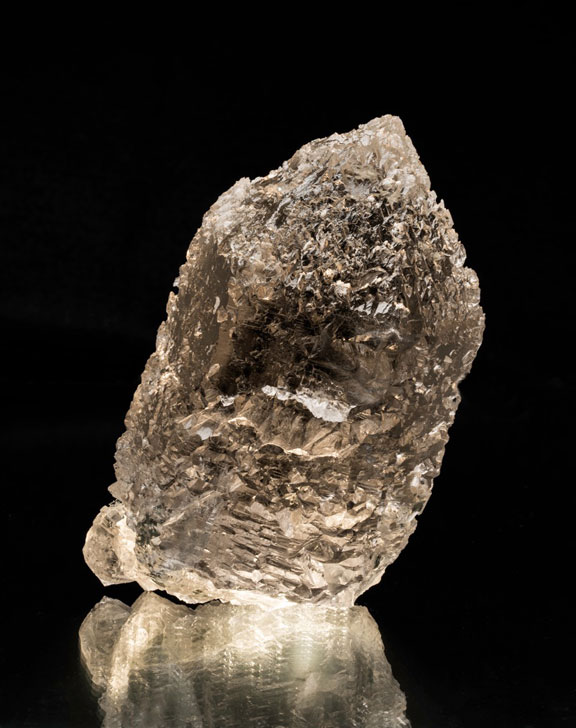February 2017
ESPN's Peach Bowl pregame show featured some colorful crystals, as shown above. The channel has been employing crystal imagery since at least 2015, as shown by the ad below.
Table of Contents
Shows and Events
Pala International News
Minerals and Mineralogy News
Pala Presents
- The Emerald Deposits of Muzo, Colombia
by Joseph E. Pogue, Ph.D.
Editor: David Hughes
Shows and Events
Tucson Time: Jan. 31 – Feb. 12, 2017
As you read this, we're settling into the world's greatest gem and mineral show. One-stop general information about individual shows, shuttle routes, and more can be obtained from the Tucson EZ-Guide.
Pala International is represented in Tucson as follows. We look forward to seeing our many friends. Visit the Pala International Show Schedule for future events.
AGTA GemFair Tucson
January 31 – February 5, 2017
Tucson Convention Center
Pala International Booth: 1016
Website
Pala joins nearly 100 exhibitors for this trade-only annual extravaganza.
The event website features an interactive floorplan allowing you to see who is exhibiting by area of the convention center.
Free seminars by notables in the world of gemstones and pearls are listed. Also listed are several special events and exhibits.
16th Annual Westward Look Mineral Show
February 3–6, 2017
Westward Look Resort
Pala International:
Suite 224, Building 20, Upper Level
Website (newly redesigned)
Pala International and three dozen other world-class mineral dealers shack up at the Sonoran Desert resort.
See Pala International's page on the Westward Look Show site. See also this dealer list.
The annual Saturday Collector Day this time will be devoted to the collection of the Rice Northwest Museum of Rocks and Minerals. (See our December 2014 writeup on the museum.) The annual Sunday Evening Program is yet to be announced.
Christophe Gobin shares some of his great mineral specimens at last year's Westward Look Show.
63rd Annual Tucson Gem & Mineral Show
February 9–12, 2017
Tucson Convention Center
Pala International:
Booths 828–929A
Website
TGMS is the largest gem and mineral show in the country. This year's theme is "Mineral Treasures of the Midwest."
For everyone who came to the 2016 Tucson Gem and Mineral Show® and would like to revisit some of the spectacular exhibits, and for those of you who weren't lucky enough to attend: For your viewing pleasure, the Tucson Gem and Mineral Society and BlueCap Productions present this video, comprised of six of our "Spotlight Cases" that were in the 2016 Tucson Gem and Mineral Show®, "Shades of Blue – Minerals of the World."
Arusha Gem Fair: May 3–5, 2016
This year's Arusha Gem Fair will be held May 3–5 in Arusha, Tanzania. Events aren't yet posted, but in addition to last year's show, tours of three mines were conducted as well as safari tours to famous national parks. Last year also saw a report on a women's scholarship fund that was initiated at the first show in 2012. The fund aims to train women in value-added skills for lapidary and jewelry technology.
As noted in the graphic above, the fair this year will include a public mineral auction of government stock as well as an auction of rough tanzanite.
Pala International News
Pala's Featured Specimen
Quartz crystal from Shigar Valley, Pakistan, 18 x 8 x 7.5 cm. (Photos: Mia Dixon)
This month we feature a massive quartz from Pakistan. It's an impressive size even for a fine quartz crystal, but this one has an added dimension that makes it quite unique. From its original crystalized state an exsolution process has created beautifully etched crystal faces with wild jagged patterns. The crystal has maintained its transparency on the inside but the surface has been transformed into a complex geometric puzzle. There is even a linear vug wrapping around the crystal like a cliffside cavern (see photos below).
Beauty on many levels and not to mention pristine with no real damage…a complete specimen. From the Shigar Valley, Gilgit-Baltistan in the northern areas of Pakistan.
Interested? Contact us.
Mineral and Mineralogy News
thINK Minerals
INK Publications, otherwise known as Connecticut's Art, Culture and Lifestyle Magazine, often covers local jewelry and fashion. Last month, INK profiled Irish transplant Tina Ashmore who began jewelry design as a child using the materials at hand: aluminum foil for rings and bracelets and colored wire insulation for beads. Her creations today display a love of color as she fashions clusters of grape-like berries from pearls and handcut gemstones like rhodolite garnet, citrine, amethyst, iolite and peridot. In November INK went behind the scenes at Becker's Diamonds & Fine Jewelry in West Hartford to find that proprietor Paul Becker himself knew by age thirteen what his life's work would be.
This month we were given a peek at an article, "David Friend Hall: Dazzle, Adventure, and Vision," by Laurencia Ciprus, who is a fine artist and interior designer as well as a journalist. So it shouldn't surprise the reader as she begins the story, "Infinite beauty accessorizes the natural world in repetitive patterns: Fibonacci numbers in proportioned cubicles of the chambered nautilus, six-fold radial symmetry in the delicate armature of a snowflake, or fractal spikes and spirals in a clutch of Romanesco Broccoli hiding in the crisper." Ciprus goes on to give a thumbnail sketch of the Yale Peabody Museum of Natural History, its collection and contributors, "a roster of scientific seers, scholars, and adventurers," to which must be added the name of David Friend, a cofounder of the Carbonite cloud backup service as well as synthesizer manufacturer ARP Instruments. As readers of our own pages know, the Peabody Museum recently unveiled the David Friend Hall, a gallery devoted to the exhibition of scores of world-class gem and mineral specimens.
In the article Friend compares the major private mineral collections with those in the art world, so the task for him and the team at Yale in obtaining suitable pieces was made somewhat easier. Each piece has a story behind it and, appropriately for a gallery named after a man who cut his teeth on tech's cutting edge, six of those stories are told by a mobile app.
Ciprus provides descriptions of several of the David Friend Hall highlights as the history of the permanent Peabody collection. The article is copiously illustrated with images, some of which we've reproduced ourselves as well as others we haven't. Even if you've seen some of the specimen photos, you may be surprised at their scale when confronted with them in the context of the Hall's landscape in photos by A. Vincent Scarano.
Lithology & Oenology
The vintners are playing up a key element of terroir, wearing their soils on their sleeves.
In the 1990s when my wife Andrea and I (your editor) would travel up the California coast, we'd often take side trips to the wineries of Paso Robles. One year, on a jaunt with the whole Hughes clan, at a winery called Dover Canyon I was quite taken with a Viognier flaunting a nose so floral, each whiff from the tasting room's slender flute-like stemware evoked a Provençal hillside. On our own, Andrea and I came upon Adelaida, a winery in the hills ten miles due west of Paso Robles. At the time, the tasting room was little more than a countertop in the warehouse. Regardless, we fell in love with Adelaida's Zinfandel and joined its wine club, Tribe of Esau. I recall on one return visit, we tried to describe what that Zin did to our tongues, but our host wasn't from the winery; he was only a volunteer, paid in freebies.
In the spring of '02 we had a delicious déjà vu when my parents celebrated their 50th wedding anniversary by taking the clan to Paris and south as far as Marseilles. While at a country inn just outside Aix-en-Provence, I used my best pidgin French to cajole the staff into planning a wine tasting route for only Andrea and me. Little did I know that the sixty-minute straight-line-road past Luberon Park to the Rhone Valley would take us to one of the most famous wine regions in the world, Châteauneuf-du-Pape. In a single cave à vin—or cellar (though this one really was a cave)—we sampled many reds from around the region. Complete novices to French wine and thus to this storied area that literally takes its name from Pope Clement V's transfer of his court from Poitiers to Avignon and his successor John XXII's construction of the "new castle," we nonetheless recognized the same tongue-twisting je-ne-sais-quois from Paso Robles. The dollar was strong against the euro and we made a killing, packing what now would be a fortune in our luggage to take home. The day of our return, Andrea read in the Los Angeles Times Magazine that "the cooler and rockier vineyards of the [Paso Robles] region's west side resemble the southern Rhone in France both in climate and soil."
So when Pala International's Bill Larson sent me a Bloomberg article titled "Soil, Not Grapes, Is the Latest Must-Know When Picking a Wine" my tongue's memory was piqued. In her story, Bloomberg's wine and spirits columnist Erin McCoy takes on "the dirty side of wine": soils alluvial, limestone, granitic, slaty, volcanic, and more. McCoy and her sources use words like smoky, savory, supple, smooth, edgy, and complex, depending on the geology. A fad? McCoy points to award-winning Southern chef Sean Brock whose farm-to-table Husk restaurants list wines not by region, but by rock type.
The lithology of oenology is not without naysayers, and McCoy quotes a geologist who says there's no direct link between geology and taste. But McCoy is convinced. She takes you, A to V, through six soil types and seven wines—but caveat emptor. This baker's half-dozen could set you back an average of $100 a bottle.
Pala Presents
The Emerald Deposits of Muzo, Colombia
by Joseph E. Pogue, Ph.D.
With Pala Presents, we offer selections from the library of Pala International’s Bill Larson, who shares some of the wealth of information in the realm of minerals and mineralogy.
Joseph Ezekiel Pogue Jr. (1887–1971) was a geologist, petroleum engineer, and economist, receiving his doctorate in geology from Yale in 1909. That same year he joined the Smithsonian as assistant curator until 1913, spending 1911 as a special student at the University of Heidelberg. He joined the faculty of Northwestern in 1914 after a year with the U.S. Geological Survey as associate geologist. Leaving Northwestern in 1917, he returned to the Smithsonian as mineral technician. The next year he became assistant director of the Bureau of Oil Conservation for the U.S. Fuel Administration. According to his NCpedia profile, his career remained in the field of petroleum.
Mineral and gemstone enthusiasts will be interested in his monograph The Turquoise (1915) as well as the present paper, The Emerald Deposits of Muzo, Colombia (1916). This latter study is a readable text, helpfully illustrated.
In this edition of our newsletter we present Part 2 of The Emerald Deposits of Muzo, Colombia, which covers minerals, age, origin, mining methods, and production.
Photograph showing how accumulated débris is cleared from working face by water let in from above. The miners on the ridge hold their work implements—long, iron crowbars with which they break down the emerald formations.
— End February Newsletter • Published 2/1/17 —
We welcome your feedback.











